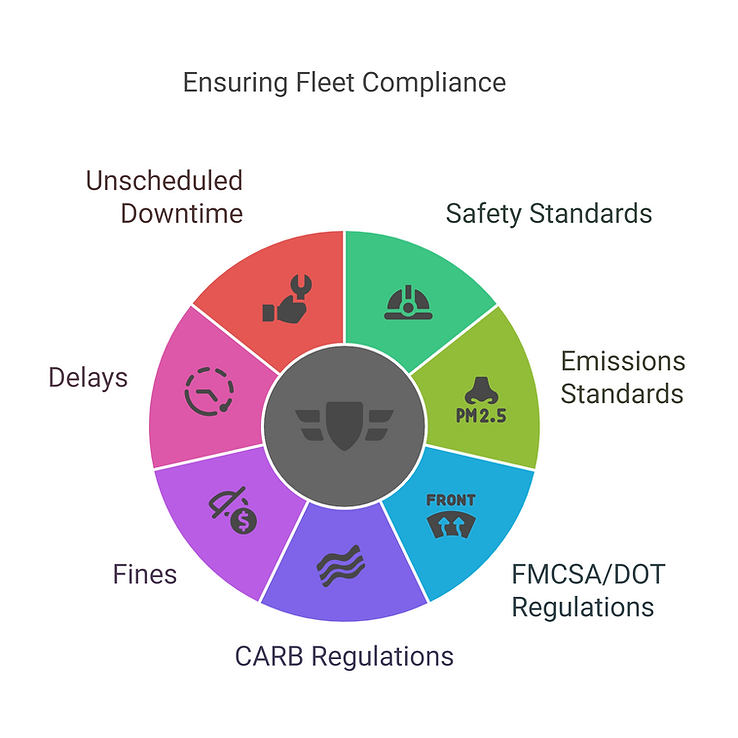Running a mixed fleet consisting of cargo vans, light-duty pickups, medium-duty box trucks, or heavy-duty haulers is a distinctive challenge in itself. Each of these types of vehicles is used for a specific purpose, wears differently, and requires different types of maintenance. That is why one solution won’t work on every vehicle.
To lower breakdowns, remain compliant, and maximize vehicle lifetimes, fleet managers require a proactive, data-driven approach.
The following are 10 best practices to optimize maintenance and achieve higher uptime in a diverse fleet
1. Employ a ‘’Tiered’’ Preventive Maintenance Schedule
Various vehicles require varying amounts of time for maintenance. Develop personal preventive maintenance (PM) schedules according to OEM recommendations, miles, engine hours, and usage patterns. For instance, if city delivery vans are utilized, they would require their brakes to be inspected more frequently than long-haul trucks. A fleet maintenance system can be used to send reminders on these parameters.
Need help managing maintenance for your diverse fleet? Kooner Fleet Management Solutions offers tailored on-site services to optimize your operations. Contact us today for a consultation.

2. Install Fleet Maintenance Management Software (FMMS)
A centralized FMMS monitors everything, work orders, maintenance history, parts, and cost per vehicle. It’s all the better if it can draw from your telematics or GPS and automatically import diagnostics and alerts. This is efficient and identifies problems ahead of time.
3. Standardize Daily Inspections
Electronic Driver Vehicle Inspection Reports (DVIRs) introduce consistency and quicker reporting for all vehicle types. Modify forms to accommodate vehicle classes, e.g., add DEF system inspections for heavy-duty trucks and suspension inspections for medium-duty trucks.
4. Include Predictive Maintenance through Telematics
Today’s telematics systems monitor more than where a vehicle is. They monitor engine performance, oil pressure, brake life, and other key items. On high-mileage trucks, predictive notifications can avoid terminal breakdowns and put trucks back on the road sooner.

5. Simplify Parts Inventory
Keep shared inventory for high-movement items like brake pads or filters, and class inventory for specialty items. Use just-in-time (JIT) ordering to keep costs low and avoid overstocking low-movement items.
6. Train Technicians by Vehicle Type
Task technicians by specialty, diesel technicians for heavy units, and generalists for light units. Cross-train where possible to enhance team flexibility and reduce service delays.
7. Monitor Total Cost of Ownership (TCO)
Track cost-per-mile, fuel economy, repair patterns, and downtime by vehicle type. This enables you to make intelligent decisions regarding which assets to replace, retain, or reassign based on long-term value.
8. Stay Current with Compliance Regulations
Ensure that all the vehicles in your fleet meet safety and emissions standards such as FMCSA/DOT and local regulations like CARB in California. Non-compliance with these regulations can result in fines, delays, and unscheduled downtime.

9. Focus on Safety-Critical Systems
Give special attention to components that affect safety, such as brakes, tires, lights, and steering. Overloaded or high-mileage trucks should be labeled for more regular inspection to prevent breakdowns and roadside distress.
10. Execute Quarterly Maintenance Audits
Check the service history, look for missed maintenance checks, and track problems that reappear. These checks enable you to optimize your maintenance process, avoid recurring problems, and make your entire fleet more reliable.
Last Ideas
Taking care of different types of vehicles need not be a hassle. With the right tools, information, and methods, maintenance can be a chance to enhance, rather than something that needs to be done. By following these 10 best practices, you can minimize downtime, improve performance, and extend asset life, regardless of the size or makeup of your fleet.
Require professional help in managing your fleet? At Kooner Fleet Management Solutions, we provide full-service solutions tailored to various vehicle fleet types. Contact us today to find out how we can help you develop a better and more efficient maintenance plan.